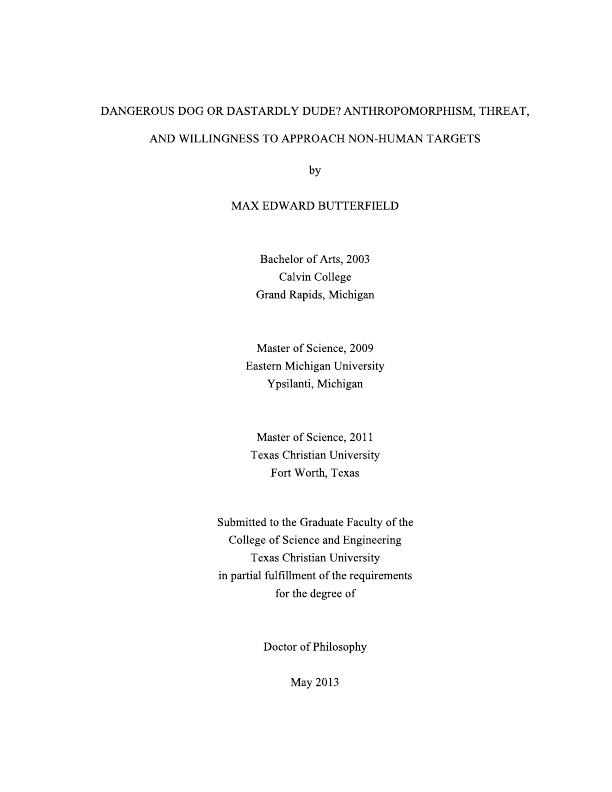Dangerous dog or dastardly dude?: anthropomorphism, threat, and willingness to approach non-human targetsShow full item record
| Title | Dangerous dog or dastardly dude?: anthropomorphism, threat, and willingness to approach non-human targets |
|---|---|
| Author | Butterfield, Max Edward |
| Date | 2013 |
| Genre | Dissertation |
| Degree | Doctor of Philosophy |
| Abstract | From marketing campaigns to family pets, human characteristics are often attributed to non-human targets, and a body of evidence has demonstrated that anthropomorphized targets tend to elicit approach. One proposed explanation for this phenomenon is that people use some of the same social and cognitive processes to determine their social judgments about both human targets and humanlike targets. For example, just as a friendly person would tend to elicit approach, a friendly anthropomorphized target (e.g., Tony the Tiger) would tend to elicit approach as well. The present studies were designed to test the boundaries of this theory by examining whether social judgments about threatening anthropomorphized targets also mimic judgments about threatening humans. Because threatening humans tend to elicit low levels of approach, it was predicted here that dangerous anthropomorphized targets would elicit low levels of approach as well.^Participants in Study 1 (n = 133) imagined interacting with non-human targets that exhibited threatening or non-threatening human behavior. The threatening anthropomorphic targets elicited less approach willingness than did the non-threatening ones, mimicking the pattern of social judgments typically observed when the targets are human. To demonstrate the absolute effect of threatening anthropomorphism on willingness to approach, participants in Study 2 (n = 100) imagined interacting with targets that exhibited threatening human behavior or no human behavior at all. Participants were less willing to approach the threatening anthropomorphized targets than the control targets. Moreover, the effects of anthropomorphism on willingness to approach were mediated by the degree to which the targets appeared dangerous. Taken together, the two studies demonstrated that anthropomorphic language does not always increase approach willingness relative to control language.^Instead, its effects depend on the type of characteristics used to activate anthropomorphism. The implications of this finding for social cognitive theory and for marketing and consumer behavior research and practice are discussed. Ultimately, these findings support the notion that people respond to friendly and fearsome anthropomorphized targets in a fundamentally social manner. |
| Link | https://repository.tcu.edu/handle/116099117/4450 |
| Department | Psychology |
| Advisor | Hill, Sarah E. |
Files in this item
This item appears in the following Collection(s)
- Doctoral Dissertations [1526]
© TCU Library 2015 | Contact Special Collections |
HTML Sitemap



